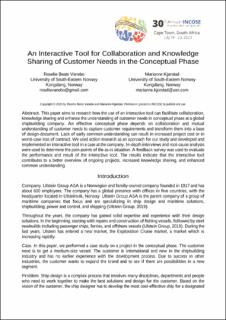| dc.contributor.author | Vanebo, Roselie Beate | |
| dc.contributor.author | Kjørstad, Marianne | |
| dc.date.accessioned | 2020-11-17T13:18:26Z | |
| dc.date.available | 2020-11-17T13:18:26Z | |
| dc.date.created | 2020-11-12T19:31:02Z | |
| dc.date.issued | 2020 | |
| dc.identifier.citation | Vanebo, R. B., & Kjørstad, M. (2020). An Interactive Tool for Collaboration and Knowledge Sharing of Customer Needs in the Conceptual Phase. INCOSE International Symposium, 30(1), 902-919. | en_US |
| dc.identifier.issn | 2334-5837 | |
| dc.identifier.uri | https://hdl.handle.net/11250/2688272 | |
| dc.description.abstract | This paper aims to research how the use of an interactive tool can facilitate collaboration, knowledge sharing and enhance the understanding of customer needs in conceptual phase at a global shipbuilding company. An effective conceptual phase depends on collaboration and mutual understanding of customer needs to capture customer requirements and transform them into a base of design-document. Lack of early common understanding can result in increased project cost or in worst-case loss of contract. We used action research as an approach for our study and developed and implemented an interactive tool in a case at the company. In-depth interviews and root-cause analysis were used to determine the pain-points of the as-is situation. A feedback survey was used to evaluate the performance and result of the interactive tool. The results indicate that the interactive tool contributes to a better overview of ongoing projects, increased knowledge sharing, and enhanced common understanding. | en_US |
| dc.language.iso | eng | en_US |
| dc.title | An Interactive Tool for Collaboration and Knowledge Sharing of Customer Needs in the Conceptual Phase | en_US |
| dc.type | Peer reviewed | en_US |
| dc.type | Journal article | en_US |
| dc.description.version | publishedVersion | en_US |
| dc.rights.holder | Copyright © 2020 by Roselie Beate Vanebo and Marianne Kj⊘rstad. Permission granted to INCOSE to publish and use. | en_US |
| dc.source.pagenumber | 902-919 | en_US |
| dc.source.volume | 30 | en_US |
| dc.source.journal | INCOSE International Symposium | en_US |
| dc.source.issue | 1 | en_US |
| dc.identifier.doi | https://doi.org/10.1002/j.2334-5837.2020.00762.x | |
| dc.identifier.cristin | 1847544 | |
| dc.relation.project | Regionale forskningsfond Oslofjordfondet: 583290 | en_US |
| cristin.ispublished | true | |
| cristin.fulltext | original | |
| cristin.qualitycode | 1 | |
